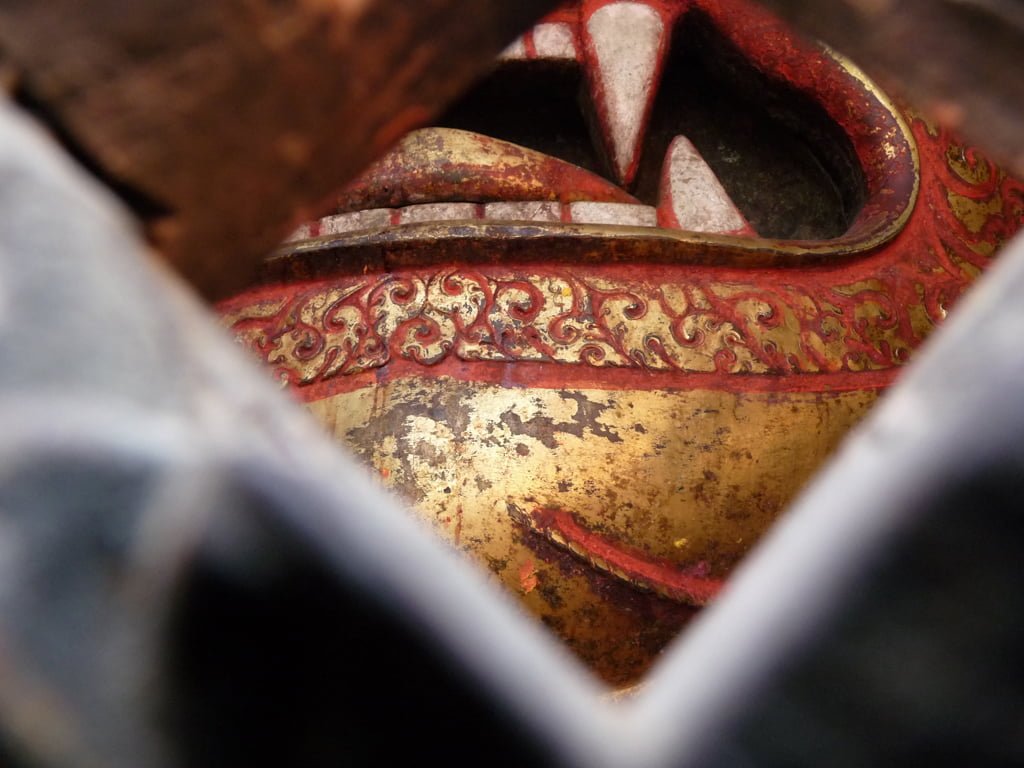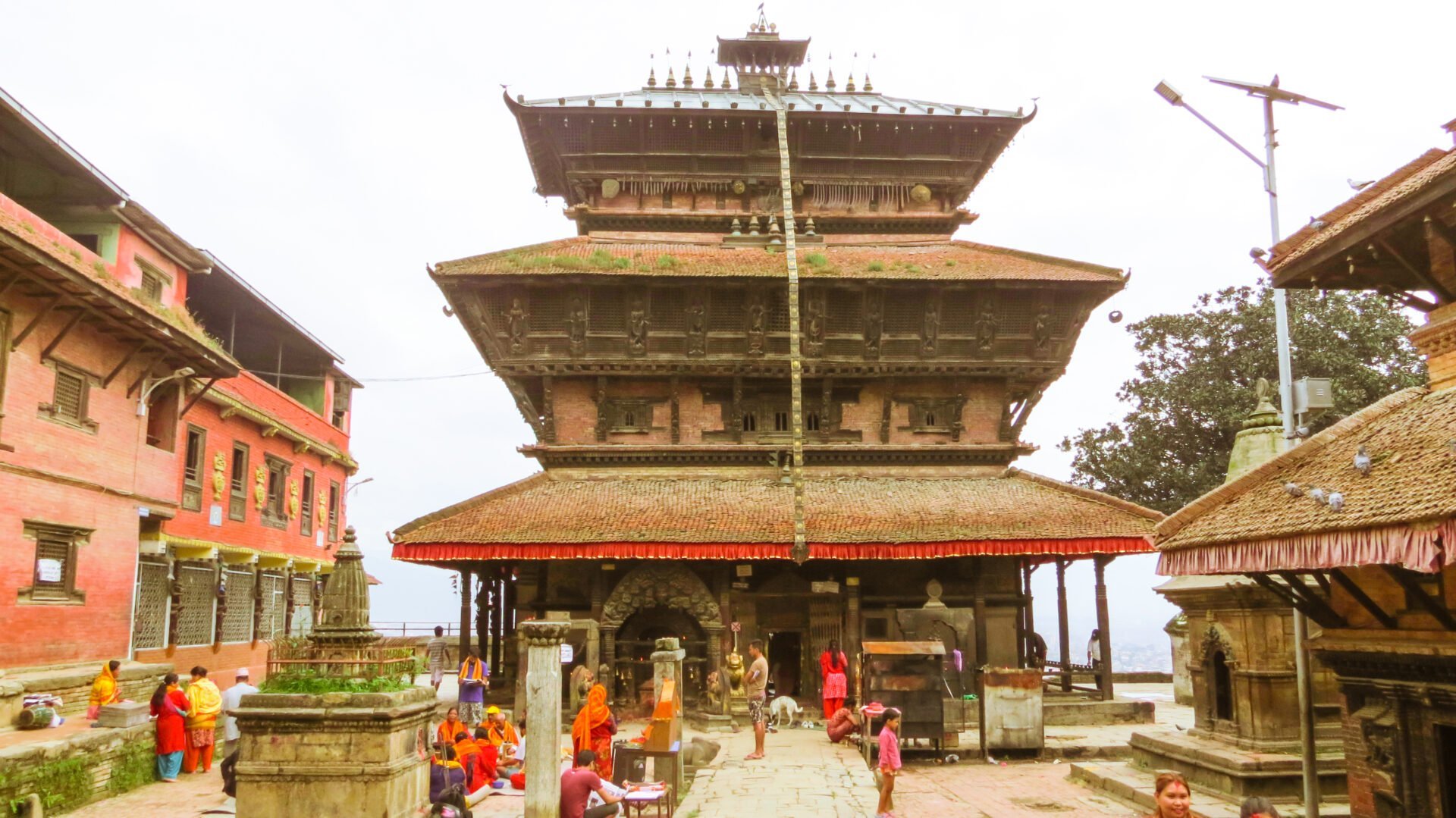Seto Bhairab: The Fierce and Sacred Mask of Nepal
According to Newar mythology, Seto Bhairab is a fierce manifestation of the Hindu God Shiva. Legend has it that Seto Bhairab once showed disrespect towards the important goddess Mahakali, tempting her wrath. As a result, he was cursed to remain caged for most of the year behind a wooden grille on the Deotali Mandir royal temple in Kathmandu, Nepal.
However, during the Indra Jatra festival in September, Seto Bhairab is temporarily released from his cage. This is the only time when devotees can catch a glimpse of this formidable deity. The festival is a grand celebration during which the mask of Seto Bhairab is displayed in Durbar Square.
During the festival, devotees shower Seto Bhairab with rice and flower petals, paying homage to his divine presence. Additionally, rice beer is poured through his fearsomely fanged mouth, symbolizing a sacred offering. Men often compete with each other to have the honor of drinking from the sacred brew, which is believed to be blessed by the rain god Indra.
Indra, the ancient Vedic god who came with the Aryan forefathers from Persia to India many centuries before Christ, is an integral part of the festival. His blessings are sought to ensure a bountiful harvest and prosperity for the coming year.
The mask of Seto Bhairab holds immense cultural significance in Nepal. It is so influential that even Nepal Airlines features the mask in their winged symbol. This symbolizes the deep-rooted connection between the deity and the people of Nepal.
The legend of Seto Bhairab serves as a reminder of the power and respect commanded by the divine. It showcases the rich mythology and religious traditions that have shaped the cultural fabric of Nepal for centuries. The Indra Jatra festival, with its vibrant festivities and rituals, provides a unique opportunity for devotees and visitors to witness the awe-inspiring presence of Seto Bhairab and seek his blessings.
Kathmandu Durbar Square
Exploring the Historic Square
Kathmandu Durbar Square, where the Indra Jatra festival takes place, is a UNESCO World Heritage Site that boasts a rich history and intricate architecture. The square is surrounded by spectacular palaces, courtyards, and temples that date back to the Malla dynasty. These ancient structures reflect the exceptional craftsmanship and artistic mastery of the Newar artisans of that era. As visitors stroll through the historic square, they are transported back in time, marveling at the exquisite carvings and intricate woodwork.
One of the notable features of the square is the Hanuman Dhoka Palace, the former royal residence of the Malla kings and later the Shah dynasty. This grand palace complex encompasses a network of courtyards, museums, and ornate halls, each offering glimpses into the regal past of Nepal. The Taleju Temple, dedicated to the goddess Taleju Bhawani, stands tall with its multi-tiered pagoda structure, exemplifying the architectural grandeur of the Malla period.
The Kumari Ghar, or the House of the Living Goddess, is another significant attraction within the square. This intricately designed building is the residence of the Kumari, a young girl revered as the living incarnation of the Hindu goddess Taleju. Visitors gather outside the Kumari Ghar in hopes of catching a glimpse of the revered deity during her occasional appearances at the window.
As visitors explore the historic square, they encounter numerous smaller temples and shrines, each adorned with ornate carvings and religious motifs. The sacred ambiance of the square, heightened by the sound of ringing bells and the scent of incense, offers a profound spiritual experience.

The Mysterious Veil of Seto Bhaira
In the heart of Kathmandu, Nepal, lies a fascinating and enigmatic symbol of Hindu mythology – the Seto Bhairab mask. This massive golden mask, also known as the White Demon, holds a significant place in both religious and cultural traditions.
The origins of the Seto Bhairab mask can be traced back to 1794 during the reign of Rana Bahadur Shah, the third king of the Shah Dynasty. It is believed to be a fierce manifestation of the Hindu god Shiva, known for his power and destruction. The mask’s imposing presence and intricate craftsmanship make it an awe-inspiring sight for all who lay eyes upon it.
One notable aspect of the Seto Bhairab mask is its association with Nepal Airlines, which prominently features the mask in its winged symbol. This connection highlights the cultural significance and deep-rooted symbolism that this mask holds for the people of Nepal.
Despite its grandeur, the Seto Bhairab mask remains a mysterious and elusive artifact. It is only visible during the Indra Jatra festival, which takes place in September. This annual festival celebrates Indra, the Hindu god of rain and king of heaven. During this time, the mask is unveiled, and devotees gather to pay their respects and seek blessings from the deity.
The Seto Bhairab mask’s existence is shrouded in myth and folklore. In Newar mythology, it is believed that Seto Bhairab once displayed disrespect towards the goddess Mahakali, tempting her terrible wrath. This tale adds an air of mystery and intrigue to the mask, making it all the more captivating to those who encounter it.
Visitors to Kathmandu’s Durbar Square are treated to the sight of this ancient artifact, which stands as a testament to Nepal’s rich cultural heritage. The mask’s sheer size and intricate details leave a lasting impression on all who witness it, evoking a sense of awe and reverence.
The Seto Bhairab mask is not only a symbol of religious devotion but also a reminder of Nepal’s history and its enduring traditions. It serves as a link between the past and the present, connecting generations and allowing them to come together in celebration and reverence.
As the mask is unveiled during the Indra Jatra festival, it takes on a newfound aura of power and mystique. Devotees believe that by offering prayers and paying homage to the mask, they can tap into its divine energy and receive blessings for prosperity and protection.
While the Seto Bhairab mask may only be visible for a brief period each year, its impact and significance extend far beyond its limited appearances. It serves as a reminder of the rich cultural tapestry of Nepal and the deep-rooted spiritual beliefs that shape the lives of its people.
Statues with Flowers
During the Indra Jatra festival in Kathmandu, Nepal, statues of deities are adorned with vibrant flowers as a symbolic offering of devotion and reverence. This act of adorning the statues with an array of colorful blooms is a traditional gesture that holds deep spiritual significance. The fragrant and visually striking display of flowers serves as a tangible expression of the devotees’ devotion and respect for the divine entities represented by the statues.
The tradition of decorating statues with flowers during religious festivals is a visual feast for the senses, creating a mesmerizing tapestry of vibrant hues and delicate fragrances. Each flower placement is deliberate and carries symbolic meaning, contributing to the overall aura of sacredness and beauty. It is a time-honored practice that bridges the earthly realm with the divine, fostering a sense of connection and harmony between the worshippers and the divine beings they revere.
The custom of adorning statues with flowers goes beyond mere decoration; it reflects the wider cultural and religious ethos of Nepal. Through this act, devotees express their gratitude and seek blessings from the revered deities, creating a spiritual ambiance that permeates the air with a sense of tranquility and reverence. The sight of statues bedecked with an assortment of blossoms is a poignant reminder of the profound connection between humanity and the divine in the rich tapestry of Nepalese traditions.

